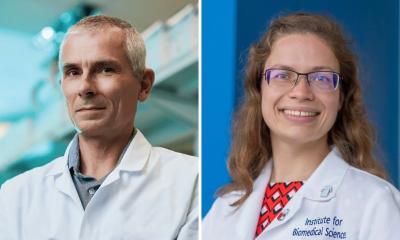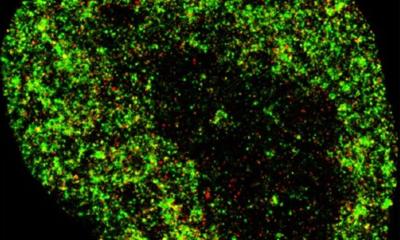Going Viral
An unusual 'friend' to help fight ovarian cancer
In some cases, the Lassa virus starts with a fever and general weakness, moving toward headache, muscle pain, possible facial swelling, deafness, and worse. About 15 percent of patients hospitalized with severe cases die. Lassa fever is contagious, endemic in West Africa, and Dr. Anthony van den Pol thinks he can use it to cure ovarian cancer.

“We can employ microorganisms to do the job for us,” van den Pol said. “Like using penicillin from a fungus to fight bacteria. They can be our friends.” The version of Lassa virus van den Pol works with has been rendered safe in combination with a variant of vesicular stomatitis virus (VSV). So there is little danger of infection. And with a grant from Women’s Health Research at Yale, van den Pol hopes to prove Lassa-VSV treatment can eliminate chemotherapy-resistant ovarian tumors. “The body does not recognize ovarian cancer as a foreign invader that would normally trigger the immune system to attack, so the cancer can continue to grow unimpeded,” van den Pol said. “But the reason these viruses can infect cancer cells, and particularly ovarian cancer cells, is that 80 percent of human tumors have a deficient innate immune response. The cancer cell cannot defend itself against a virus.”
About one in every 60 women in the United States will develop ovarian cancer. It is the eighth most common form of cancer for American women and the fifth leading cause of death. One of the reasons ovarian cancer can become deadly is that it recurs in about 80 percent of patients who receive successful surgery and chemotherapy treatment. And when it comes back, it often invades deep into large portions of the abdomen and pelvis where it is hard to find and difficult to remove surgically. Worse, the cancer often mutates to develop a resistance to chemotherapy.
But the ability of cancer cells to mutate can hold a key to their possible destruction. Normal, healthy cells detect a virus and generate interferon, a type of protein that signals the presence of a pathogen, increasing the expression of up to 200 genes that then serve to block infections through various mechanisms of the immune system. Previous research has found that even as advanced cancer with a greater number of mutations becomes more resistant to chemotherapy, the large number of gene mutations within the DNA of the cancer cells make them more susceptible to infection from a virus. “A virus doesn’t have a brain but it has an evolutionary mission to find things to infect,” van den Pol said. “Viruses also replicate to seek and destroy on their own. They don’t need to know where the tumors are but seem able to find most if not all of them.”
Van den Pol’s team has studied viruses for this purpose over the past 15 years, focusing in part on variants of VSV. However, VSV on its own likes to infect electricity-conducting cells of the nervous system called neurons, causing damage. So the researchers began testing viruses containing the genes of different unrelated viruses together with some VSV genes to discover any that do not infect neurons. They found that using a combination of Lassa and VSV was completely safe when injected into normal and immune-deficient mice. And when Lassa-VSV was tested in mice with a brain tumor called glioma, the virus crossed the blood-brain barrier and selectively infected the tumors. Untreated mice died within a month, but those treated with Lassa-VSV survived indefinitely with no trace of the tumors.
In addition, the virus can activate the body’s natural immune system to target cancer cells, eventually taking over the job of killing them. “The immune system has a very long memory,” van den Pol said. “The virus is only around for two or three weeks.” And when it’s gone, the virus appears to have no lasting negative effect. “The virus seems to be completely eliminated,” van den Pol said. “It can’t be detected.”
Now van den Pol is using the WHRY grant to test whether it can have the same safe, positive effect on ovarian cancer. He credits a collaboration with the lab of Dr. Gil Mor, Professor of Obstetrics, Gynecology, and Reproductive Sciences, who has spent years studying ovarian cancer. “If Lassa-VSV worked for only a small percentage of women or helped women survive longer, it could be dramatically different from any current treatment option,” van den Pol said. He hopes to eventually secure funding to ensure his virus is safe to test in humans, expressing confidence in the future of viruses as therapy for deadly cancers. “Microbes scare us,” van den Pol said. “But they can also be beneficial in helping us target and kill cancer cells.”
Source: Yale Cancer Center
27.04.2017







